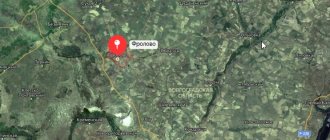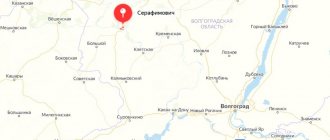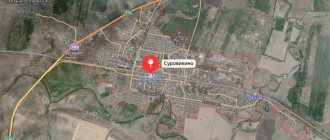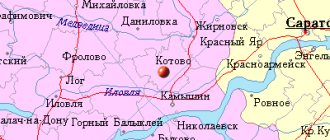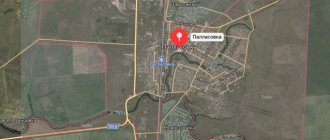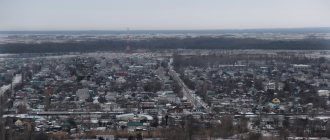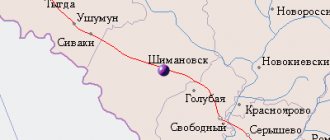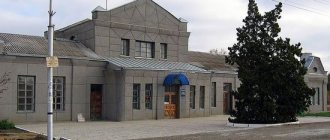History and modernity of the city of Dubovka, Volgograd region. Weather and work.
The city of Dubovka is located in the Volgograd region, at a distance of 37 km from Volgograd. The settlement covers an area of 20 km2. Guests of Dubovka will be able to visit the following attractions:
- an Orthodox church built in 1762, which is called the “Assumption Cathedral”;
- The Holy Ascension Monastery, which is of historical value, was founded in 1762;
- Having been on the right bank of the Volga, you can visit the “Vodyanskoye Settlement” - the ruins of a Golden Horde settlement;
- Among the amazing monuments erected by nature is the “Oak Patriarch” located in Dubovka. The height of this tree, which has Federal significance, is more than eighteen meters;
- the Church of the Intercession of the Blessed Virgin Mary, built in 1850 and restored in 1988;
- The merchant's house, built in 1887, has existed to this day and became the Dubovsky Museum of Local Lore;
- a mass grave of Soviet soldiers who died in the bloody battles of the Great Patriotic War, which became a monument.
The city's transport system is represented by a bus station, from which it is possible to get to Volgograd, Volzhsky, Kamyshin and Saratov. You can move around the village by buses and minibuses of various routes.
Holy Ascension Dubovsky Monastery
The main purpose of our trip was the main attraction of Dubovka - the Holy Ascension Monastery, founded in 1871.
The Ascension women's community (the future Holy Ascension Monastery) was founded with donations from the tradesman Posokhin and Archpriest John of the Pokrovsky. The first residents settled in the outbuilding, built in 1865. And at the beginning of the twentieth century, 270 sisters lived in the monastery.
The fate of the monastery after the revolution is tragic and sad. The monastery was closed. His abbess and several other nuns were shot. Its walls with its unique gates, the churches of the Blessed Virgin Mary and the Ascension of the Lord were destroyed, and the monastery’s valuables were looted. And its buildings housed various institutions.
In 1991, the monastery was revived and returned to the Russian Orthodox Church. The condition of the monastery at that time was very poor (everything was worn out and broken). This can be judged by the remains of the old wall.
Some buildings had to be rebuilt. The belfry and the Church of John the Baptist were restored. The monastery has its own garden, vineyard, fish pond, its own cows (by the way, the nun sister sells very tasty dairy products in the monastery store), and the monastery lands are sown.
In the temple today you can see the relics of John of the Intercession (which were transferred from the crypt of John of the Intercession in 1992) and an icon from Athos with particles of the relics of 40 saints, which was donated to the monastery in 1994.
Believers come here to find help from higher powers, to give thanks for a fulfilled request, and to ask for the blessings of the saints.
At the entrance to the monastery there are the Holy Gates with a bell tower and the chapel of John the Baptist.
And a little further away there is a well with cold spring water “Holy Source”. Now there, as well as throughout the monastery, construction work is underway. But you can get water from a well. That's what we did.
The location for this well was not chosen by chance. During the construction of the monastery, an acute shortage of drinking water was discovered. We had to walk very far to get her. According to legend, a well with tasty water was dug in the place pointed out by the founder, builder and founder of the monastery, Archpriest John of Pokrovsky. During his prayers, a miracle happened to him, which served as a sign for choosing a place.
The monastery is not located in Dubovka itself. If you drive from Volgograd (along the Saratov highway), before reaching the city, you need to turn left. The monastery buildings can be seen from the highway. When we were driving into the city, we didn’t notice the monastery. And they hit him, already returning back.
History of education and development
The settlement, located on the territory of modern Dubovka, dates back to BC. It was here that archaeologists discovered signs of ancient human settlement and the remains of a mammoth. In addition, Sarmatian tribes lived on these lands and the city of the Golden Horde was located, the ruins of which are still a historical landmark of the settlement.
In the 18th century, a Russian guard line was organized on the right bank, the purpose of which was to get rid of robberies and robbery, as well as to protect river trade routes. During one of the raids, most of the soldiers of the fortification located on the territory of Dubovka were killed. The settlement presumably received its name because of the oak forests that surrounded it.
According to information found in documents preserved from those times, the city was founded by decree of the country's government in 1734. Volga Cossacks lived in Dubovka with their families, who were supposed to protect the surrounding territories. However, instead, local residents were engaged in harboring fugitive criminals. In 1774, the Dubov Cossacks swore allegiance to the rebel Pugachev who came to the city, and also helped him with weapons and supplies. After an unsuccessful attempt to capture Tsaritsyn, Pugachev was captured and executed, and Dubovka, who supported him, fell out of favor.
At the beginning of the 19th century, merchant fairs began to be held in the village, and therefore the development of the city began. By the middle of the century, 25 factories of various types were built in Dubovka, there were more than 3,500 thousand residential buildings, and the population exceeded 12,000 people. In the same century, a railway line was built connecting the Don and Volga rivers, which passed through Tsaritsyn. This caused the economic decline in Dubovka. But despite this, in 1913 the city's population was more than 18,000 people. The reason for this was that rich merchants, despite the decline in trade, remained to live in Dubovka.
In 1919, the power of the soviets was established in the city and in connection with this, during the civil war, Red Banner troops were stationed in Dubovka.
During the Second World War, wounded soldiers who took part in the bloody battles of the Battle of Stalingrad were brought to the former front-line Dubovka. That is why there are a large number of fraternal churches in the city in which about 2,500 people are buried. More than 6,000 city residents heroically sacrificed their lives during the war.
References
Notes
- ^ abcde State Committee of the Russian Federation on Statistics. Committee of the Russian Federation for Standardization, Metrology and Certification. No. OK 019-95 January 1, 1997 “All-Russian classifier of objects of administrative-territorial division. Code 18 208", ed. changes No. 278 / 2015 dated January 1, 2016. (Goskomstat of the Russian Federation. Committee of the Russian Federation for Standardization, Metrology and Certification. No. OK 019-95 January 1, 1997. Russian classification of administrative divisions) (OKATO).
Code 18 208 , as amended by Amendment No. 278/2015 of January 1, 2016). - ^ abc State Committee of the Russian Federation on Statistics. Committee of the Russian Federation for Standardization, Metrology and Certification. No. OK 019-95 January 1, 1997 “All-Russian classifier of objects of administrative-territorial division. Code 18 208 501”, ed. changes No. 278 / 2015 dated January 1, 2016. (Goskomstat of the Russian Federation. Committee of the Russian Federation for Standardization, Metrology and Certification. No. OK 019-95 January 1, 1997. Russian classification of administrative divisions) (OKATO).
Code 18 208 501 , as amended by Amendment No. 278/2015 of January 1, 2016). - ^ a b Federal State Statistics Service (2011). All-Russian Population Census 2010. Volume 1 [All-Russian Population Census 2010, vol. 1]. All-Russian Population Census 2010 [All-Russian Population Census 2010] (in Russian). Federal State Statistics Service.
- "26. The size of the permanent population of the Russian Federation by municipalities as of January 1, 2022". Federal State Statistics Service. Retrieved January 23, 2022.
- ^ abcde Law No. 1026-OD
- "On the Calculation of Time". Official Internet portal of legal information
. June 3, 2011. Retrieved January 19, 2022. - Post office. Information and computing center of OASU RPO. ( Post office
).
Search for postal service objects ( postal Search for objects
) (in Russian) - ↑
Federal State Statistics Service of Russia (May 21, 2004). Population of the Russian Federation as part of federal districts. [Population of Russia, its federal districts, constituent entities of the Federation, districts, urban settlements, rural settlements - administrative centers and rural settlements with a population population more than 3000 people] (XLS). All-Russian Population Census of 2002 [All-Russian Population Census of 2002] (in Russian). - All-Union Population Census of 1989 Population of Union and Autonomous Republics, Autonomous Regions and Districts, Territories, Regions, Urban Settlements and Village District Centers [All-Union Population Census of 1989: Current Population of Union and Autonomous Republics, Autonomous Regions and Districts, Territories, Regions , districts, urban settlements and villages performing the functions of district administrative centers]. All-Union Population Census of 1989 [All-Union Population Census of 1989] (in Russian). Institute of Demography of the National Research University: Higher School of Economics [Institute of Demography of the National Research University: Higher School of Economics]. 1989 - via Demoscope Weekly
.
Sources
- Volgograd Regional Duma. Law No. 1026-OD of March 14, 2005 “On establishing boundaries and granting status to the Dubovsky district and the municipalities within it.” Came into force on the date of official publication. Published: “Volgogradskaya Pravda”, No. 50, 97, March 23, 2005, June 1, 2005 (Volgograd Regional Duma. Law of March 14, 2005 No. 1026-OD “On establishing boundaries and assigning status to the Dubovsky district and its constituent in its composition to municipalities. In force
from the date of official publication.)
Employment
In the city of Dubovka there are such industries as: a bread factory, a confectionery shop, a winery, a meat processing plant, as well as enterprises for the production of mineral water and building materials. These organizations offer residents of the locality employment for various positions depending on the education and qualifications of the applicant.
In addition, on the Internet it is possible to get acquainted with a fairly large number of vacancies offered by entrepreneurs and organizations in the city. The minimum wage in Dubovka is 15,000 rubles.
Houses for maternal capital in the Volgograd region
Church of the Holy Life-Giving Trinity
All buildings in the parish of the Holy Trinity (church, baptismal temple, well, chapel, utility rooms) are wooden and were erected in 2006.
Previously, there was a city garden with a church (built in 1876), which was destroyed in the 40s of the twentieth century.
Today, on the well-groomed territory of the parish, literally buried in greenery and flowers, with paved paths, a gazebo, a children's playground, a chapel on a spring, with a small pond, only a gatehouse has remained from the old church.
Dubovka Hotels
There are several hotels in Dubovka that can offer overnight accommodation to tourists. It is quiet, peaceful, and the rooms are quite comfortable. Compared to the same Volgograd hotels, local ones also benefit in price.
Hotels can offer single and double rooms. The average cost is from 900 RUB per person. Some hotels offer a sauna with a swimming pool, cafes and bars with entertainment. Also at the hotel you can book a boat trip along the Volga with fishing or an excursion to Volgograd to places of military glory. Prices on the page are for April 2022.
The shops
The shops in Dubovka are the most ordinary. Tourists are not left without food and essential goods. As for souvenirs, they make good glass and wood products here.
In addition, the city is famous for its handmade carpets and gardens. Here you can buy unusual “dubovka” melons, which are valued for their special taste and aroma, as well as grapes. The city has a real gardening and berry stronghold. The name sounds like a checkpoint. Only with a gardening twist.
Also, as souvenirs from Dubovka you can take away various embroidery and candles, which are made by the sisters of the Holy Ascension Convent.
2 things to do in Dubovka
- Sit under an oak tree - this huge oak tree is located on the shore of the Volgograd reservoir. Stepan Razin and his cheerful comrades visited here, and the landowners squandered huge fortunes on cards. They say that if you make a wish under an oak tree and touch the tree, it will come true.
- Meet the boy Semyon - his ghost walks near the stop where truckers rest. She is known as "Mother-in-Law". The boy says that he came from Crimea, but his stepmother kicked him out. On the Volga he was killed by wolves. Now he's cold. And since Semyon was not an obedient child, now he is forced to scare people for 100 years.
